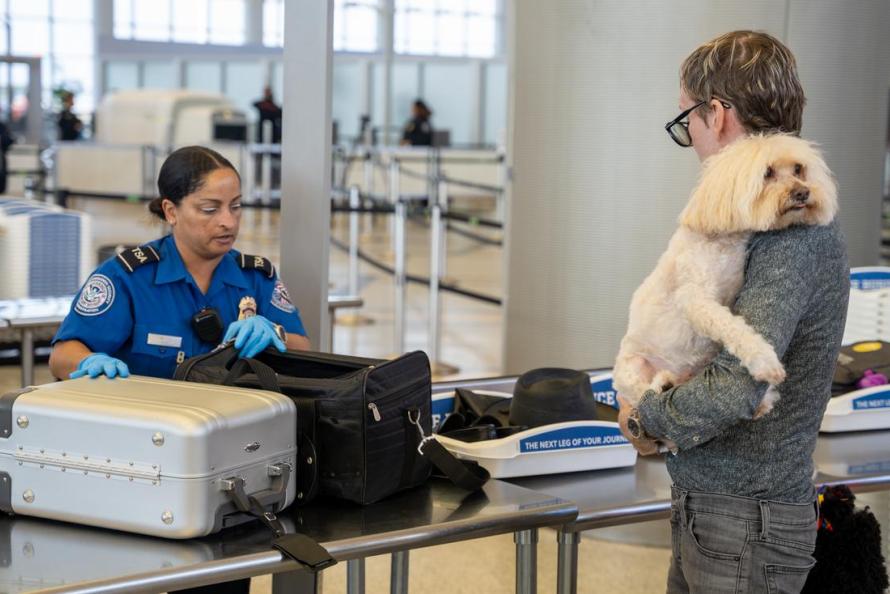HOUSTON, TX, 2023-Sep-28 — /Travel PR News/ — With the holiday travel period set to begin in mid-November, Houston Airports and the Transportation Security Administration (TSA) are expecting to see a marked increase in the number of pets brought to the security checkpoints at George Bush Intercontinental Airport and William P. Hobby Airport. Traveling through the security checkpoint with your pet can be easy when you know what to expect.
“TSA recognizes that for many pet owners, their animals are an extension of their family, and they want to travel together,” said TSA Deputy Federal Security Director for Colorado Anne Cross. “Becoming familiar with the screening procedures and how to clear security quickly and easily is the first step to embarking on a great trip with your pet.”
According to the TSA, at least once a month, passengers flying out of Houston attempt to send their cat or dog through an airport X-ray machine. Pets should not be screened through an X-ray unit. “It is dangerous to put pets through X-ray machines, as it exposes them to unnecessary radiation,” said Cory Stottlemyer, Spokesman for BARC Animal Shelter. “On top of this, X-ray machines can also be extremely stressful for pets. The loud noises and unfamiliar surroundings can be overwhelming and cause anxiety, leading to behavioral problems, such as aggression or excessive barking, which can lead to the pet possibly being denied entry onto the flight.”
Small pets should travel in the cabin of the aircraft with their owners. TSA will screen pets via the security checkpoint. Below is what pet owners can expect:
- All pets should be brought to the security checkpoint in a hand-held travel carrier.
- Remove the pet from the carrier just prior to the beginning of the screening process.
- Place the empty travel carrier so it can be X-rayed.
- Never place a pet in the X-ray tunnel.
- The X-ray at the security checkpoint is used to screen passengers’ personal property and carry-on luggage only.
- If possible, carry the pet during the screening process.
- Alternatively, a pet can walk through the screening process if the owner has the pet on a leash.
- A TSA officer will give the pet owner’s hands an explosive trace detection swab to ensure there is no explosive residue on the owner’s hands.
Once the screening process is complete, owners should return the pet to the travel carrier at the re-composure area away from the security checkpoint. This location helps ensure the safety of the pet as well as other passengers.
Other helpful travel tips to make your trip thru security as easy as possible include:
- Acclimate the pet to the process of traveling by familiarizing it with the travel carrier in the days leading up to the trip. This familiarization will help ensure the pet is more relaxed as it travels through the security process and the airport.
“We encourage airport travelers with pets to come prepared with a plan on how they will safely remove their pet from its carrier when traveling through airport security. Pet owners know their pet’s behavior, so be mindful if they’re already nervous in large crowds or around strangers,” said Stottlemyer. “We’d suggest talking to your veterinarian to possibly get your pet prescribed some medication to help calm them down. Review both your airport and airline’s guidelines as well regarding pets.”
- Test out your pet carrier too ahead of your travel day to better acclimate your pet to it and make sure it works properly. Bring any favorite toys or blankets that might help assist in keeping your pet calm. An additional harness and leash might be beneficial when going through security as well. Bring a collapsible food and water bowl as well as some extra treats and food to provide your pet once you’re through security as well.
If your pet is also animal-reactive, travelers should be on the lookout for “working” canines and handlers at the airport. Areas where it is common to see a working dog at airports may include a security checkpoint or in the terminal concourse. If you encounter a working canine, please consider shifting to an alternate checkpoint so that there is no interference with a government working dog’s tasks.
Know the temperament of your pet and ensure that you can maintain control of it in a busy and potentially crowded transportation environment.
Familiarize yourself with the pet relief areas at Bush and Hobby airports.
Media Contact:
HAS.PIO@houstontx.gov
281-233-1234
Source: Houston Airports
###

